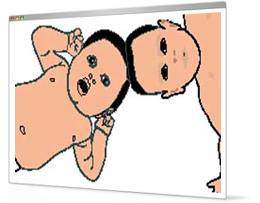My UPD8
You need to login before you download the free activities. To sign up click on join upd8 below.
Conjoined twins

Type: Activity
Learning Strategy: Scientific writing
Topic: Reproduction
Another pair of conjoined twins have been separated, but debate always rages about whether it is medically possible, or ethical desirable. In the activity pupils judge whether babies Clarence and Carl should be separated. It's a great context to learn how to distinguish between scientific and ethical judgments.
Published: 20th January 2005
Reviews & Comments: 4
Try the activity
- Activity sheet
Downloaded: 1774 times - Teachers notes
Downloaded: 1124 times
You will need Acrobat Reader installed to open the activity sheets.
Curriculum link
KS3 7b: reproduction: fertilized eggs divide into 2, 4, 8 etc to make a foetusKS 4: ideas and evidence: the power and limitations of science in addressing social questions, and the ethical issues involved.
Running the activity
Page 1 is a stimulus sheet, to be printed onto transparency or photocopied for pupils. It tells the story of babies Clarence and Carl, who doctors are planning to separate later this year. The formation of twins and conjoined twins is explained in terms of cell division.
Page 2 is an activity sheet for pupils to tackle in groups. Pupils use case studies to identify important issues for deciding whether to separate conjoined twins. They use these ideas to make a judgment about Clarence and Carl.
The aim is for pupils to start appreciating the difference between arguments that are scientific, and those that are ethical.
The case studies of Laleh & Laden and Jodie & Mary illustrate ethical judgments - what are the rights and wrongs of the cases?
Laleh and Laden were operated on because they desperately wanted to live independently.
Jodie and Mary were separated to save one life - without the operation both babies may have died.
The case studies of Masha & Dasha and Guiseppina and Santina illustrate scientific judgments - is it possible to separate the twins? Are the benefits greater than the risks?
Doctors decided that it was medically possible to separate Guiseppina and Santina. The potential benefits outweighed the risks.
Doctors believe that trying to separate Masha and Dasha is too risky. These twins will not be separated.
Web links
News links
- BBC News
- A news story with pictures of the famous case of the Bijani twins, who died after separation in July, with a description of the operation in images
- Newsround
- A BBC Newsround science debate page, with an illustrated diagram and basic information
- Conjoined twins
- For more information on both the science and the ethical issues:
Reviews & Comments
Write your online review to share your feedback and classroom tips with other teachers. How well does it work, how engaging is it, how did you use it, and how could it be improved?
Conjoined twins review
Sep 25th, 2007

I did this with a lower abiltiy year 7. It was a really good way of helping them understand the difference between identical and non identical twins.
Reviewer: sue kennedy
Conjoined Twins
Jun 11th, 2005

Lacking a little in detail - the pupils wanted to know the chances for successful surgery and whether the vein could be split etc but really good overall - they found it interesting and stimulating and came up with some good ideas. Most of mine voted on allowing the babies to decide when they grow up.
Mrs I Freedman, Queens School, Bushey
Reviewer: Ilana Ordman
Conjoined twins
May 8th, 2005

My year 7 pupils really enjoyed this upd8 at the end of a reproduction unit. I agree with other reviewers that a little more detail would have been useful but I have given this 4 stars because I was impressed with the way pupils focussed on the activity in pairs and gave answers to some quite difficult questions. I found it useful to produce a simple writing frame so that pairs could jot down their ideas before class discussion. Pupils have been quite eager to find out more for homework! Excellent citizenship material for science and very thought provoking.
Reviewer: Tony Stevens
Conjoined Twins
Mar 20th, 2005

I have just used this title towards the end of teaching my Year 7 class reproduction (7B). The reason for using it was that the pupils had a lot of questions and genuine interest in twins but in particular conjoined twins.
They enjoyed this activity but would have liked a bit more detail about some of the examples given - in particular about what surgery would have entailed. perhaps another part of this could have been about the procedures that doctors use both before and after the attempted separation.
My class debated in groups about whether to separate or not and could not reach a unaminous decision although three quarters voted to separate. They and I enjoyed the discussion issues that such an activity stimulates and it made them think and reflect on their own lives too. Good for citizenship too. Well done.
Mrs Jane Briggs, Winterton Comprehensive School
Reviewer: Jane Briggs

Related Activities
Biology / Reproduction
QCA / 7B Reproduction
Ideas about Science / Benefits/drawbacks
- Diagnosis - A and E activity from Wikid
- Addicted to energy
- Backstage science
- Three Parents
- Cannabis
- Bulb danger
- Biodiesel
- Sputnik at 50
- Sea tubes to solve climate crisis?
- If... the lights go out
- Sulphur
- Say No to poor health
- Poo power or nuclear power?
- Our atmosphere: the hottest investment on the Planet!
- New faces
- Bionic Vision
- Top Dog
- Mobiles for kids?
- Hoodie be gone
- Pump Wars